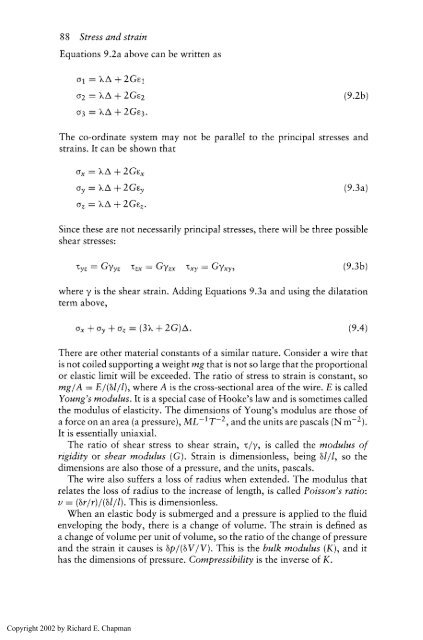Physics for Geologists, Second edition
Physics for Geologists, Second edition
Physics for Geologists, Second edition
Create successful ePaper yourself
Turn your PDF publications into a flip-book with our unique Google optimized e-Paper software.
88 Stress and strain<br />
Equations 9.2a above can be written as<br />
The co-ordinate system may not be parallel to the principal stresses and<br />
strains. It can be shown that<br />
Since these are not necessarily principal stresses, there will be three possible<br />
shear stresses:<br />
where y is the shear strain. Adding Equations 9.3a and using the dilatation<br />
term above,<br />
There are other material constants of a similar nature. Consider a wire that<br />
is not coiled supporting a weight mg that is not so large that the proportional<br />
or elastic limit will be exceeded. The ratio of stress to strain is constant, so<br />
mg/A = E/(61/1), where A is the cross-sectional area of the wire. E is called<br />
Young's modulus. It is a special case of Hooke's law and is sometimes called<br />
the modulus of elasticity. The dimensions of Young's modulus are those of<br />
a <strong>for</strong>ce on an area (a pressure), ML-~T-~, and the units are pascals (N mP2).<br />
It is essentially uniaxial.<br />
The ratio of shear stress to shear strain, t/y, is called the modulus of<br />
rigidity or shear modulus (G). Strain is dimensionless, being 6111, so the<br />
dimensions are also those of a pressure, and the units, pascals.<br />
The wire also suffers a loss of radius when extended. The modulus that<br />
relates the loss of radius to the increase of length, is called Poisson's ratio:<br />
v = (6r/r)/(61/1). This is dimensionless.<br />
When an elastic body is submerged and a pressure is applied to the fluid<br />
enveloping the body, there is a change of volume. The strain is defined as<br />
a change of volume per unit of volume, so the ratio of the change of pressure<br />
and the strain it causes is 6p/(6V/V). This is the bulk modulus (K), and it<br />
has the dimensions of pressure. Compressibility is the inverse of K.<br />
Copyright 2002 by Richard E. Chapman






